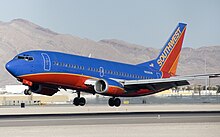Fleet commonality: Difference between revisions
Appearance
Content deleted Content added
complement |
other example: F-16 |
||
| Line 7: | Line 7: | ||
Commonality policies may be defined in a variety of ways, depending on the operator: |
Commonality policies may be defined in a variety of ways, depending on the operator: |
||
* for civilian aircraft: |
|||
| ⚫ | |||
* By model, |
** By model, same generation (e.g. Boeing New Generation [[737 Next Generation|737-700]], [[737 Next Generation|737-700]]ER, [[737 Next Generation|737-700]]C) |
||
| ⚫ | |||
| ⚫ | |||
* By |
** By family (e.g. Boeing 737) |
||
* By |
** By manufacturer (e.g. [[Boeing]]) |
||
** By engine (e.g. [[Rolls-Royce RB211]]) |
|||
* Any combination of the above |
** Any combination of the above |
||
* for military aircraft, the same can be said: |
|||
** By model, same generation (e.g. Lockheed [[F-16|F-16]]A, [[F-16|F-16]]B) |
|||
** By model, different generations (e.g. Lockheed [[F-16|F-16]]A/B, [[multirole]] [[F-16|F-16]]C/D) |
|||
| ⚫ | |||
[[Category:Civil aviation]] |
[[Category:Civil aviation]] |
||
Revision as of 14:54, 7 January 2012
This article provides insufficient context for those unfamiliar with the subject. (March 2010) |

Aviation commonality describes the economic and logistic benefits of operating a standardized fleet of aircraft that share common parts, training requirements, or other characteristics.
Commonality lowers the cost of operating a fleet of aircraft by reducing the quantity and variety of spare parts needed. Pilots and mechanics may also be very quickly "familiarized" to multiple types of aircraft that share common operating and maintenance procedures, reducing downtime.
Commonality policies may be defined in a variety of ways, depending on the operator:
- for civilian aircraft:
- for military aircraft, the same can be said:
